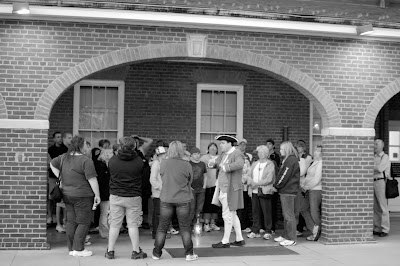The City Hall on King St. was designed to look like the previous City Hall which burned down in 1871
Sometimes it is good to have a purpose when visiting a town, especially a historic town like Old Town Alexandria. It is so easy to get sucked into all the retail stores and restaurants that you forget that the city itself has a rich history. So on this day, I brought a copy of the Old Town historic walking tour guide inside the Alexandria Visitors Guide (source of my captions*) and took in the soul of the city through the eyes of my camera. I definitely left with a better admiration for the history of this beautiful downtown area in Virginia.
Ramsay House Visitor Center at 221 King St. is the replica of the home by one of the city's founding fathers, Scottish Merchant William Ramsay.
Gadsby's Tavern was once an important social and political center in the United States. Englishman John Gadsby operated the tavern from 1796 to 1808, holding dance assemblies, theatrical and musical performances, and meetings. George Washington, John Adams, Thomas Jefferson, James Madison and MArquis de LAfayette are among the prominent patrons who drank and slept here. Pictured above is the dining room with the original fireplace.
Server at the Gadsby's Tavern
The Athenaeum was built in 1851 as the Bank of the Old Dominion, and it served many prominent people, including Robert E. Lee. It is now home to the Virginia Fine Arts Association, which presents exhibits of paintings and fine arts.
The Carlyle House was once the home of wealthy Scottish merchant and city founder, John Carlyle, the impressive mansion features the finest of early georgian architecture in the city. Carlyle served as his own architect, building the house in three years and finishing in 1754. Today, the home is a museum offering visitors a glimpse at the life of Alexandria's wealthiest families.
The Captain's Row is one of the oldest blocks in Alexandria. It's a scenic street with a cobblestone road and historic row houses framed by trees. Many of the houses on this street were built by sea captains at a time when Alexandria was a major point of entry for ships from overseas.
American flags are proudly flown all over Old Alexandria including this one on Prince St. in Captain's Row.
508 Cameron St. is a recreation of a townhouse once owned by George Washington. The original home was built in 1796 to provide convenient quarters for the President when business or weather prevented his return to Mt. Vernon.
The Yeaton-Fairfax House is an interesting building ofGeorgian and Federal architecture. It was built around 1803 by William Yeaton, a merchant ship owner from New Hampshire who came to Alexandria to establish himself as a builder and architect. He is credited for designing the Washington family tomb in Mt. Vernon.
Christ Church, circa 1773. It is said that George Washington played a part in the building of the church and an original pew holder. Robert e. Lee was another member of the congregation.
One of several late 18th and 19th century tombstones on the grounds of Christ Church
The Lyceum was originally built as a venue for lectures, scientific experiments and reading, the building has served a series of purposes in its long history, from Civil War hospital to the nation's first Bicentennial Center. Today, it is home to the Alexandria's History Museum.
A statue to commemorate the soldiers who lost their lives in the Civil War
On the courtyard of City Hall is Market Square; the country's oldest farmers market. Above, a tour guide takes visitors on a tour of the Market Square.
The Old Town theater is the first permanent theater in Alexandria. It was built in 1914
Friendship Firehouse Museum, the home of the first volunteer fire company in Alexandria. The firehouse was built in 1855, remodeled in 1871, and renovated in 1922. Inside, you can see historic fire-fighting technology and a meeting room furnished exactly the way it was in during the late 19th century.






































































